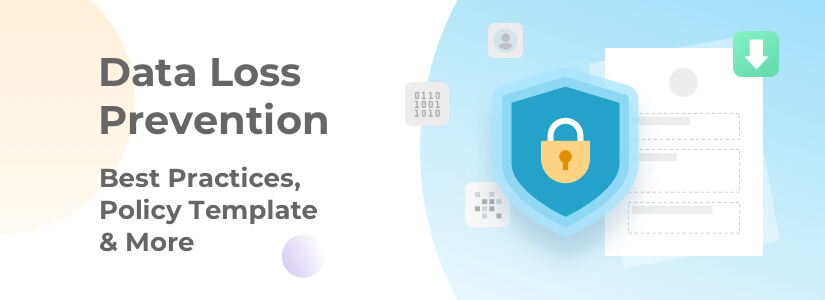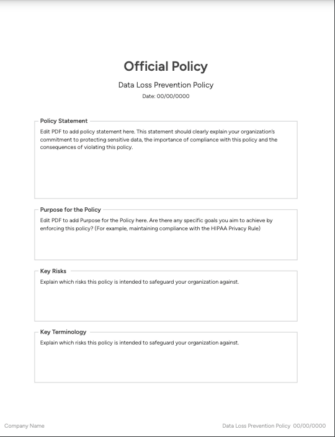Data Loss Prevention: Best Practices, Policy Template & More

Data loss — how big of a deal can it really be?
Let’s ask the 94% of companies that never recover from severe data loss; more than half of those companies end up closing two years after the incident. For the more financially minded members of our audience, some estimates place the cost of small instances of data loss — fewer than 100 files — between $18,000 to $35,000. For large-scale incidents, that number can balloon up to $15.6 million.
That’s nothing to say of the threat data loss poses to business continuity, productivity and, in some cases, your organization’s reputation.
The key to avoiding data loss? A data loss prevention policy.
In this article, we’ll explain why it’s essential for every organization to develop a data loss prevention policy, as well as provide you with the guidance you need and a free template you can use to create your own.
What Is Data Loss Prevention?
Data loss prevention (DLP) is a comprehensive strategy — including policies, procedures and security systems — used to safeguard critical data assets. Data loss prevention aims to prevent the unauthorized transmission or exposure of sensitive data, both within an organization’s network and when data is transferred externally. It also mitigates the risks associated with data breaches — whether intentional or accidental — by enforcing controls, monitoring data movement and providing real-time alerts and remediation measures.
What Is a Data Loss Prevention Policy?
A core component of any DLP strategy, data loss prevention policies are rules that organizations establish to govern the handling, storage and transmission of data. These policies define how sensitive information should be classified, protected and monitored to prevent authorized access or sharing.
The primary goal of any data loss prevention policy is to ensure the privacy and security of an organization’s data assets, while maintaining compliance with applicable regulations and mitigating risks associated with data breaches or data loss incidents.
Why Your Business Needs a Data Loss Prevention Policy
The primary goal of any data loss prevention policy is to safeguard sensitive data from unauthorized access, sharing or leakage. This sensitive data can include intellectual property, customer data, employee data, financial records and other proprietary information — essentially, any information your organization wouldn’t want to fall into the wrong hands.
By implementing security systems, access controls and incident response plans, DLP policies add a layer of protection to your existing security strategy. But security isn’t the only benefit a data loss prevention policy offers:
- Compliance: Many regulations — from industry-specific regulations such as the Health Information Portability and Accountability Act (HIPAA) and the Gramm-Leach-Bliley Act (GLBA) to general regulations such as the General Data Protection Regulation (GDPR) and the Sarbanes-Oxley Act (SOX) — include specific data security requirements, including those specific to data loss prevention. A solid data loss prevention policy can help your organization ensure compliance — and avoid the costly consequences of non-compliance.
- Cost-savings: Data breaches and data loss can lead to significant financial losses. In addition to financial penalties resulting from non-compliance, these costs can also include any expenses associated with investigations, legal action, fines and potential compensation to affected parties. Therefore, creating and implementing a comprehensive DLP policy is a smart way to protect your bottom line.
- Visibility: To create an effective data loss prevention policy, organizations must first take stock of what data they actually have on hand. Fully accounting for what data currently exists not only increases visibility, but can also offer valuable insight into how your company’s stakeholders, employees and end users leverage that data.
- Reputation: Losing sensitive data is never a positive thing — doubly so if that data is customer data. Data loss, particularly loss resulting from a data breach, can call a company’s reputation into question and lead customers to wonder whether their information is safe. DLP policies introduce safeguards in the form of access controls, cybersecurity software, encryption and more, securing customer data and protecting organizations’ reputations.
- Data management: For a data loss policy to be successful, it must include data classification systems, encryption and data retention policies — all three of which play an important role in data management. On top of securing data, data loss prevention policies come with the added benefit of helping businesses better organize and control their data, which allows for more informed decision-making and greater operational efficiency.
Key Components of a Data Loss Prevention Policy
Now that we’ve clarified why a data loss prevention policy is essential to any organization, let’s take a closer look at the components that comprise an effective DLP policy:
- A policy statement that clearly explains the organization’s commitment to protecting sensitive data, the importance of compliance with the policy in question and the consequences of violating that policy
- A system for classifying data based on its sensitivity; examples of classifications include public information, internal use only, confidential data, restricted data, personally identifiable information, proprietary data and unclassified data
- An inventory of all the types of data the organization handles, including data at rest (in storage), in transit (moving from one system to another) and in use (actively being processed or handled)
- Access controls, which are a set of policies and procedures for controlling access to data; common examples include user authentication, role-based access controls and least-privilege access principles
- Encryption requirements for sensitive data both in transit and at rest to protect it from unauthorized access or interception
- Data handling procedures, including procedures for data creation, storage, transmission, sharing and disposal
- An incident response plan detailing how the organization will respond to data breaches, security incidents or policy violations, including specific steps for investigation, containment, mitigation and reporting
- Procedures for continuously monitoring data access and usage, as well as an audit schedule for assessing compliance with DLP policies
- A security awareness and training program for employees and third-party contractors to educate them about DLP policies, data security best practices and the importance of data protection
- Guidelines for securing endpoints such as computers and mobile devices to prevent data leaks or unauthorized access; these guidelines should include the use of antivirus software, firewalls and security patches
- Network security measures, such as encryption, secure connections and intrusion detection and prevention systems, to secure data in transit
- Data loss prevention software and tools to help monitor, detect and prevent data breaches and policy violations
- Guidelines for third-party vendors and partners that handle the organization’s data to ensure that they comply with DLP requirements
- A section dedicated to compliance that addresses relevant data protection laws, industry regulations and standards that govern data handling and security
- Procedures for documenting and maintaining records related to data classification, access logs, incident reports and policy revisions
- Escalation procedures that define the hierarchy of actions the organization should take in case of data loss prevention policy violations, including warnings, disciplinary actions and legal recourse
- Reporting mechanisms that employees and stakeholders can use to confidentially report suspected policy violations, security incidents or data breaches
- Key performance indicators that the organization can use to measure the effectiveness of its DLP program, including incident response times, compliance rates and incident recurrence rates
How to Create a Data Loss Prevention Policy
Ready to create your own data loss prevention policy? Here are the key steps you need to follow — as well as a link to download our free DLP policy template.
- Before starting work on your data loss prevention policy, you’ll want to first conduct a thorough risk assessment. A risk assessment can help you identify potential threats to your data, which you’ll want to note within your DLP policy, and any vulnerabilities within your existing systems that you’ll need to resolve.
- The next step is to do your research and familiarize yourself with any applicable laws or regulations and their DLP requirements. Remember, there are both general regulations and industry-specific regulations to consider; you’ll want to ensure that all of your bases are covered to avoid non-compliance. If your organization does not already have a compliance team or compliance manager dedicated to this purpose, you may want to retain the services of a qualified consultant.
- With your risk assessment and compliance review out of the way, you’re ready to begin building your data loss prevention policy. Rather than try to take everything on at once, which could lead to gaps in coverage, start small by prioritizing your most important, most valuable or most at-risk data.
- Now that you’ve narrowed the scope of your policy to a specific subset of data, determine where that data is located. It could be in any number of locations, such as shared network drives, databases, cloud storage, emails, instant messaging apps, hard drives or electronic archives.
- Once you’ve located your data, start to organize it based on its criticality, taking care to classify any sensitive information.
- Classifying your data into different categories is essential because it provides the basis for your access controls. With your data classified and organized, begin to set different access controls for different data types, depending on their sensitivity. Consider not only which users should have access to what data, but how you intend to validate users’ identities and restrict unauthorized access.
- Classifying your data will also enable you to set the appropriate security levels for different types of data depending on its sensitivity. At this step of the process, you’ll also want to evaluate different security systems, such as firewalls, encryption, anti-virus and anti-malware software, intrusion detection systems and authentication tools.
- If you haven’t already, now is the time to create specific data archiving and retention policies to accompany your data loss prevention policy. Data retention policies define everything from what format data should be kept in and how long that data should be stored for to whether data should be archived or deleted and who has the authority to dispose of it. Generally speaking, it’s in your organization’s best interest not to hold onto data any longer than is necessary, especially if it’s customer data.If you need help creating a data retention policy, we recommend using our free template as a jumping off point.
- Define standard operating procedures for employees to follow in accordance with your DLP policy, as well as any follow-up actions employees should take in response to suspicious activity or in the event of a data breach. Make sure this information is easy to understand and readily available to your employees at all times to increase the likelihood of compliance.
- In order for a DLP policy to work, it’s important that all relevant parties be aware of its existence. Effectively communicate DLP requirements and expectations to employees, including the consequences of a policy violation. Be sure to provide sufficient training resources and educate both employees and stakeholders on the importance of data security.
- If your organization retains the service of third-party service providers, take some time to establish criteria for evaluating potential vendors and their internal data loss prevention policies.
- Invest in an anomaly detection system to proactively identify unusual activity and unauthorized data usage, and use it to continuously monitor designated data while it’s at rest, in transit and in use.
- Finally, to ensure that your data loss prevention is consistently kept up to date, create a policy review schedule and periodically test the efficacy of your DLP policy, making adjustments as needed.

